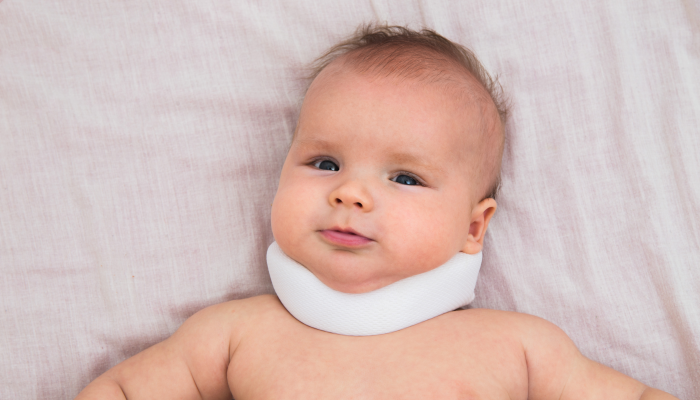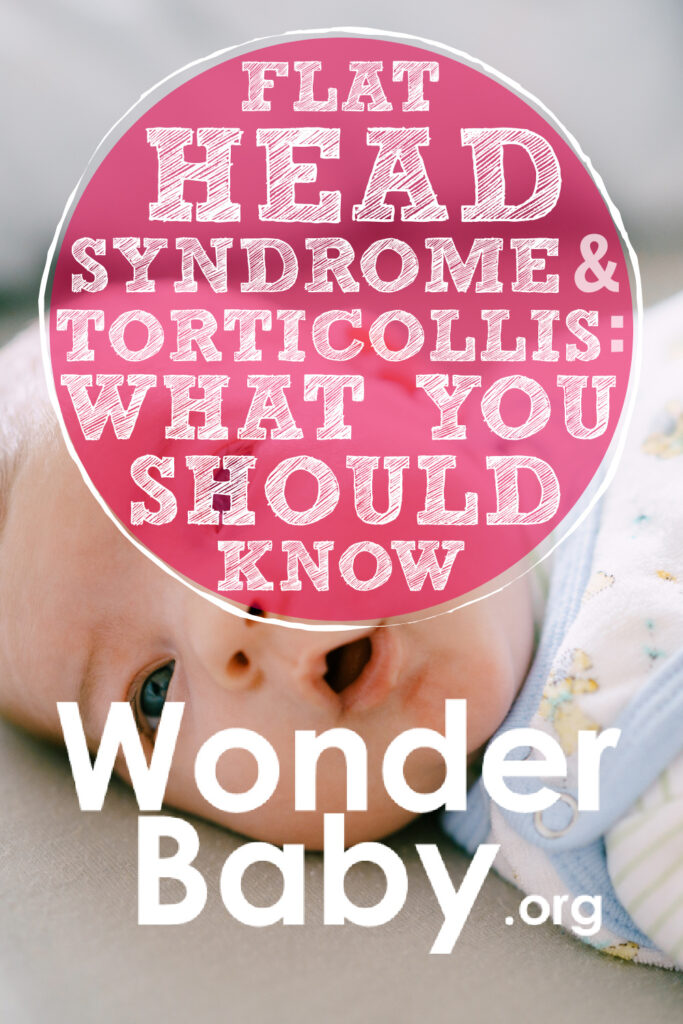Flat Head Syndrome and Torticollis: What You Should Know

- Torticollis is caused by a tightening of the sternocleidomastoid muscle in the neck.
- Unresolved torticollis can lead to flat head syndrome.
- Gentle stretching and physical therapy can correct torticollis.
- A special helmet is sometimes needed to correct flat head syndrome.
- Helmets for flat head syndrome need to be measured and adjusted frequently to keep your baby healthy and safe.
As you are playing with your new baby, there are many things that you probably pay attention to. You may listen to the tone of their voice, the movement of their arms, and the way they respond to you. When you play with your baby or watch them interact with the world, you might notice that their head is not perfectly round.
Unfortunately, some babies develop tight muscles on one side of their neck, making it more difficult to turn one way than another. When these babies lay down, they will always have pressure on one side of their head, and their soft skull is at risk of becoming misshapen.
If your baby always seems to have their head turned to one side, they may need treatment for flat head syndrome and torticollis.
Torticollis: What You Should Know

Torticollis, also called wryneck, is a relatively common condition in children. According to experts at Boston Children’s Hospital11. Torticollis. Boston Children’s Hospital. https://www.childrenshospital.org/conditions/torticollis, torticollis affects about 1 in 300 babies.
What is Torticollis?
The word torticollis comes from the Latin words “tortus,” which means twisted, and “collum,” which means neck. It is a condition where a muscle on one side of the neck is tighter and shorter than the other, forcing the head into a turned or tilted position.
Experts at the Cleveland Clinic22. Torticollis. Cleveland Clinic. 2022. https://my.clevelandclinic.org/health/diseases/22430-torticollis explain that there are two different types of torticollis: congenital and acquired.
- Congenital: A baby with congenital torticollis is born with the condition. This is the most common type.
- Acquired: This type of torticollis develops later in life and is less common than congenital. It often appears in children between the ages of four and six months.
What are the signs of Torticollis?
If you are worried about torticollis, there are several signs you can look for. These include:
- Head tilted to one side
- Limited movement of the baby’s neck and head
- Baby having one shoulder higher than the other
- Swollen muscles in the neck
- Neck pain
- Headaches
- Tight muscles in the neck
- Tremors of the neck muscles
If you notice any of these symptoms in your child, speak to your pediatrician right away. The earlier you start treatment for torticollis, the easier it is to correct, and the fewer side effects your child will experience.
What are the causes of Torticollis?
Each type of torticollis has a different cause. When a baby is born with congenital torticollis, it can be hard to identify the root cause. In congenital torticollis, there is a shortening of one sternocleidomastoid muscle, the largest muscle that connects the bottom of your neck to the base of the skull. This may be due to your baby’s position in the womb, abnormal development of their muscles, or a genetic abnormality.
Acquired torticollis is typically caused by swelling in your child’s throat. This may start out as gastroesophageal reflux disease, injury to the neck, severe ear infections, buildup of scar tissue, or vision problems.
Flat Head Syndrome: What You Should Know

Flat head syndrome is also known as plagiocephaly. Babies with plagiocephaly develop a flat spot somewhere on their head, usually on the back or on one side. Flat head syndrome can be mild to severe.
Infants develop flat spots on their head because the bones in their skull have not fused together. Babies’ brains grow at an extremely rapid pace, and they need a soft, unfused skull to provide enough space for their growing brain.
Experts state that up to 50%33. Plagiocephaly (Flat Head Syndrome). Cleveland Clinic. 2023. https://my.clevelandclinic.org/health/diseases/10691-plagiocephaly-flat-head-syndrome of infants develop mild plagiocephaly, and it often resolves when parents start repositioning their baby or giving their infant more tummy time.
How Flat Head Syndrome and Torticollis are Related
Flat head syndrome is closely related to torticollis. In fact, torticollis is the most common cause of flat or misshapen heads in children.
When a baby suffers from torticollis, it is difficult for them to move their heads from one side to the other. Because of this, the same part of their head experiences pressure every time they sleep or lay down. When a baby’s soft skull is exposed to pressure in the same area over and over, the shape of their skull can change.
Early Detection and Diagnosis

With close monitoring of your baby and regular visits to your pediatrician, you should be able to detect torticollis or flat-head syndrome fairly quickly. The earlier you detect either problem, the easier it is to correct.
If you are concerned about your baby’s tight neck muscles or the shape of their developing head, take them to visit their pediatrician. A pediatrician can help determine the severity of your child’s problem and what steps should be taken to correct it.
Treatment Options for Flat Head Syndrome and Torticollis

While many babies are born with congenital torticollis, there are many treatment options available to correct the problem. Because torticollis is often the cause of flat head syndrome, treating torticollis is usually the best place to start.
Torticollis Treatment
If you notice that your child constantly turns their head to one side or seems to experience pain when you stretch their neck, you may need to seek help from their pediatrician. Physicians from Yale Medicine44. Torticollis. Yale Medicine. https://www.yalemedicine.org/conditions/torticollis recommend the following for the treatment of torticollis:
- Physical therapy. Gentle stretching and strengthening of the neck muscles can help in most cases of torticollis. A physical therapist can usually teach parents how to stretch their baby’s neck safely.
- Tummy time. Tummy time is a great tool for managing torticollis and preventing flat-head syndrome in babies. If your baby hates tummy time, try distracting them or giving them short, frequent sessions throughout the day.
- Botox injections. In more severe cases, a baby may need botox injections to relax their tight muscles. Babies who get botox injections should also participate in physical therapy to keep the muscles in their neck loose and flexible. Babies may need several botox treatments over a few weeks.
- Surgery. In the most extreme cases, a baby may need surgery to correct the tight muscles in their neck. To correct torticollis, the surgeon will make a small incision in the neck and lengthen the sternocleidomastoid muscle on one side. The American Academy of Orthopedic Surgery55. Congenital Muscular Torticollis (Twisted Neck). OrthoInfo. 2023. https://orthoinfo.aaos.org/en/diseases–conditions/congenital-muscular-torticollis-twisted-neck states that about 10% of children with congenital muscular torticollis need surgery.
Flat Head Syndrome Treatment
If your baby develops a flat spot on their head, don’t panic. In an interview with CHOC, Dr. Magge66. Infant head shape problems and helmet therapy: What parents should know. CHOC. 2021. https://health.choc.org/helmet-therapy-what-parents-should-know/ stated that babies often do not even start helmet therapy until they reach four to six months of age. Helmet therapy can correct the shape of a baby’s head until about twelve months of age.
Treatment options for flat head syndrome include:
- Tummy time. Like torticollis, flat head syndrome is very responsive to tummy time. In young infants, tummy time should only be done while the baby is awake and an adult is supervising.
- Helmet therapy. Babies who need helmet therapy usually only need it for a few months.
- Boppy pillow. Laying your baby on a boppy pillow instead of the floor can reduce pressure on their head and prevent or treat flat head syndrome. The best boppy pillow is one that is soft but still supportive.
FAQs
Can flat head syndrome correct itself without treatment?
Flat head syndrome may correct itself without treatment, depending on the age of the child and the severity of the problem. In very young children, correcting torticollis or offering more tummy time may be enough to correct flat head syndrome without more extreme measures. As children get older, the chance of needing a helmet for flat head syndrome increases.
How long will my baby have to wear a helmet for their flat head syndrome?
Babies who need corrective helmets usually have to wear them for several weeks or months. Because babies grow so rapidly, they often have to get several helmets in different sizes to accommodate their head.
Your baby may start out wearing their helmet all day, every day, and slowly progress to using their helmet only at night.
How soon should I expect to see improvement with physical therapy for torticollis?
Parents can often see improvements in their child’s torticollis within a few weeks of starting physical therapy. Being consistent is the best way to ensure that physical therapy is effective. If you do not see improvement after three to four weeks of physical therapy, you may need to speak to your pediatrician about other treatment options, such as botox injections or surgery.
How can I tell if my baby’s torticollis is improving?
As your baby’s torticollis improves, you will notice more flexibility in their neck and more head movement from one side to the other. You may also notice that they start sleeping with their head in a more neutral position rather than turned to the side. Your child’s pediatrician and physical therapist can help determine how well your baby is progressing.
References
- Torticollis. Boston Children’s Hospital. (n.d.). https://www.childrenshospital.org/conditions/torticollis
- Torticollis. Cleveland Clinic. (2022, February 28). https://my.clevelandclinic.org/health/diseases/22430-torticollis
- Plagiocephaly (Flat Head Syndrome). Cleveland Clinic. (2023, April 13). https://my.clevelandclinic.org/health/diseases/10691-plagiocephaly-flat-head-syndrome
- Torticollis. Yale Medicine. (n.d.). https://www.yalemedicine.org/conditions/torticollis
- Congenital Muscular Torticollis (Twisted Neck). OrthoInfo. (2023, April). https://orthoinfo.aaos.org/en/diseases–conditions/congenital-muscular-torticollis-twisted-neck
- Infant head shape problems and helmet therapy: What parents should know. CHOC. (2021, January 22). https://health.choc.org/helmet-therapy-what-parents-should-know/

The information WonderBaby provides is not intended to be, and does not constitute, medical or other health advice or diagnosis and should not be used as such. Always consult with a qualified medical professional about your specific circumstances.
Related Posts

Eye Conditions and Syndromes, Visual Impairment
Neuralink Announces Plans to Restore Sight to the Blind with Brain Chip
Elon Musk’s company Neuralink has announced plans to begin human trials of its new “Blindsight” brain chip by the end of 2025.

Health & Nutrition
Can Baby Skin Care Products Expire?
Is that forgotten tube of diaper rash cream still safe to use? Learn more about the expiration dates of popular skin care products for infants.

Health & Nutrition
Boosting Immunity in Kids: 3 Tips for a Healthy Winter
Parents can help boost their kids’ immunity during cold and flu season by maintaining healthy eating, sleeping, and exercising habits in the winter.